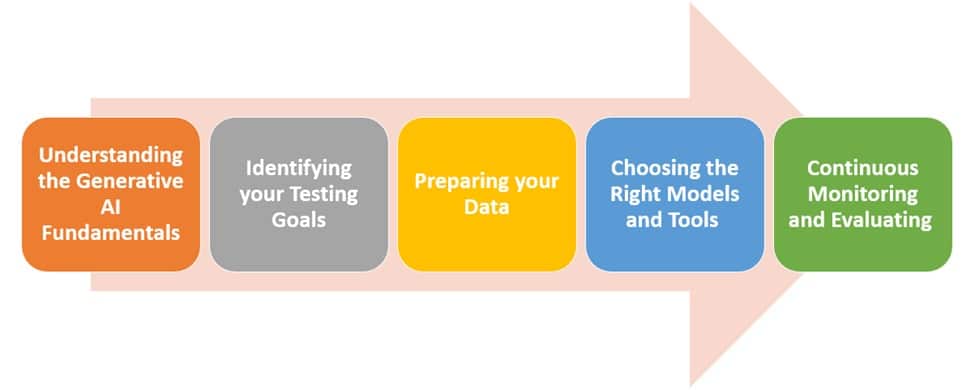Accelerate Success with AI-Powered Test Automation – Smarter, Faster, Flawless
Start free trialWhat exactly is Generative AI?
Generative AI, is the latest buzzword emerging among organizations to enhance productivity and innovation. Also referred as genAI, it expands the capabilities of AI by enabling applications to analyze existing data and create new data that can be in the form of text, images, audio, and video. It uses ML algorithms to train models to understand patterns and data.
In order to provide a better customer experience, teams are increasingly beginning to use the power of generative AI by integrating ML and AI throughout their technology stack.
As per the Generative AI market report, it is anticipated to soar from a USD 8.65 billion valuation in 2022 to a whopping USD 188.62 billion by 2032.
In this article, we explore the transformative impact of Generative AI on QA cost management.
How Does Generative AI empower QA teams?
For every team, there is always one ongoing challenge: how to ensure comprehensive testing while enhancing the quality assurance (QA) capabilities. Traditional AI systems are programmed to perform specific tasks. Generative AI relies on models and algorithms that pick up patterns from vast amounts of datasets, and then generate new content and make new predictions.
The introduction of Generative AI in QA provides some innovative solutions to improve productivity, streamline QA procedures, and empower QA teams.
| Aspect | How Generative AI works | How it Empowers QA teams | Example of a Banking application |
| Automated Test Case Generation | Generative AI can automatically generate diverse test cases based on application functionalities. | Reduces the manual effort and time required for test case, leading to increased test coverage | It can analyze transactional processes and automatically generate test cases covering various scenarios like deposits, withdrawals, and transfers. |
| Dynamic Test Data Generation | Dynamically generates realistic test data. | Reduces the manual creation and maintenance of test data thereby enhancing test coverage | It can generate diverse customer profiles based on their various investment, withdrawal, or deposit behaviors, ensuring comprehensive testing of the payment processing system. |
| Self-Healing Test Scripts | Identifies and rectifies issues in test scripts automatically, without the need for manual intervention. | Minimizes the human intervention necessary for identifying and fixing issues in test scripts. | If a UI element’s identifier changes, Generative AI can adapt the test script by recognizing the change and making required changes without needing manual corrections. |
| Identifying complex issues | Analyzes historical data, including code and logs, to identify hidden patterns and predict potential defects. | Early defect identification enables developers and QA teams to address critical issues proactively, and lower post-release costs. | By analyzing past releases, it can predict potential performance issues or security issues. |
| Test Environment Management | Predicts optimal test conditions, automates test environment setup, and minimizes downtime. | Environments are optimally configured for testing, resulting in decreased downtime. | It can predict the peak load conditions and ensure that test environments are automatically scaled to handle the anticipated load. |
| Intelligent Test Prioritization | Uses intelligent algorithms to prioritize test scenarios based on criticality, ensuring thorough testing of essential functionalities. | It directs focus on data-driven and critical scenarios. | It can prioritize testing of critical customer data functionalities. |
| Continuous Learning | As the AI model is exposed to more scenarios, it can accurately create better test cases and test data that reflect the system’s behavior. | AI models can learn and improve, saving valuable time and resources; allowing QA teams to focus more on complex tasks that require human intuition and creativity. | It can learn and adapt to changing patterns and improve the application’s performance. |
| Predict Security Vulnerabilities | Predicts potential security vulnerabilities by analyzing data and enabling proactive security measures. | Ability to comprehensively scan the software helps to find vulnerabilities that might otherwise slip through. | It can analyze past security incidents and predict potential web vulnerabilities, allowing the teams to address them preemptively. |
How can QA teams embrace Generative AI?
Generative AI not only empowers QA teams to optimize their processes and resources but also accelerates the entire application development at a reduced cost. It can result in an effective and cost-efficient QA framework that aligns seamlessly with the rapid pace of application development.
Here are some steps for teams looking to incorporate generative AI into their QA processes:

1. Understanding the Generative AI Fundamentals
Generative AI uses machine learning algorithms to create models that can generate data based on the patterns from the original or training dataset. Your QA teams need to understand these fundamentals to effectively embrace it.
2. Identifying your Testing Goals
Are you aiming to reduce your manual testing efforts, improve test coverage, identify defects earlier, or a combination of these? Define your testing goals, and identify areas where Generative AI could bring you the most value.
3. Preparing your Data
To be effective, generative AI models need high-quality datasets that are relevant to real-world scenarios. This is a crucial step for accurate and effective AI model training.
4. Choosing the Right Models and Tools
There are various Generative AI models and tools. Research each of the tool’s strengths and weaknesses and select the one that aligns with your QA team’s requirements.
5. Continuous Monitoring and Evaluating
Evaluate your KPIs against the generative AI’s performance. You can also update your datasets and retrain the model whenever there are any changes to the application.
You will have to be careful about ethical issues such as data privacy and security. Based on your organization’s policy, you can set guidelines to ensure ethical and responsible usage of Generative AI in QA.
Conclusion
You can leverage Generative AI to transform your application testing and automation efforts. With Webomates’ Testing as a Service and full suite of Intelligent Automation testing tools, you
can always attain up to 100% test coverage and seamless execution of test cases along with drastically reducing the regression test execution times.
Schedule a demo to discover the full potential of our AI-driven software testing solutions that can boost your business outcomes, increase productivity, and accelerate product releases. You can also reach out to us at info@webomates.com
Tags: AI Testing, Generative AI, Generative AI in Software Testing, Intelligent automation, Software Testing

Leave a Reply